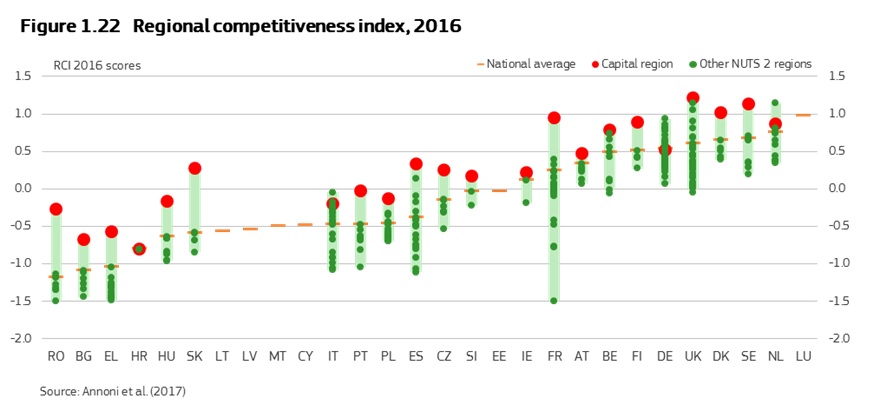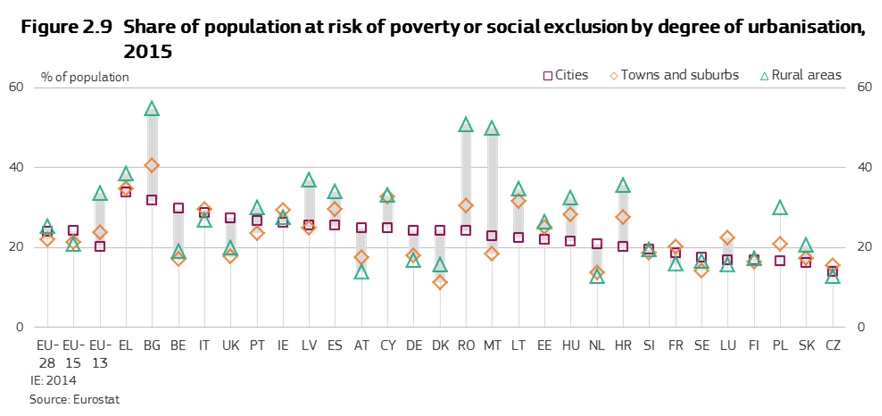Two indicators, three questions and one bus
Edited on
24 June 2019What lies ahead for urban cooperation and URBACT in the next cohesion policy framework?

Based on the findings of the 7th Report on Economic, Social and Territorial Cohesion published by the European Commission (EC), October 2017 URBACT organised a workshop 6 March in Paris. The EC, the Committee of the Regions and Eurocities joined Member States’ and cities’ representatives in a reflection on the role of cities and of the territorial cooperation in the frame of the Cohesion Policy post-2020.
Two indicators,
Philippe Monfort from the Analysis Unit of DG for Regional & Urban Policy set the scene presenting the main findings of the 7th Cohesion Report. The conclusions of the report were quite bitter – “the convergence machine was broken after the crisis” – among Member States and sometimes within them as well. While the report gives a thorough view of the convergence or divergence of the different regions and cities, 2 indicators are particularly interesting regarding the ways cities have been performing lately.
- Regional Competitiveness Index (RCI) – measuring the ability of a region to offer an attractive and sustainable environment for firms and residents to work and live in – indicates that capital and metro regions continue to be the main drivers of regional competitiveness in Europe. If in some Western countries a high RCI for capitals and metropolitan areas has a spill-over effect on the neighbouring areas, it is not the case in the Eastern part of Europe. This shows that it is still rather difficult to pinpoint which are the exact ingredients that make a city competitive and if those same ingredients fit for all parts of Europe.

- Risk of poverty and social exclusion – at the opposite of RCI is AROPE, a combination of three indicators that measures poverty or social exclusion in the EU. The figures from the Report show that poverty remains high, especially in the Baltic and Southern Member States. For the urban areas it is declining in the EU-13 countries but increasing in the EU-15 ones. This is a strong indicator of the fact that while some cities provide a better quality of life than the sub-urban and rural areas around them (EU-13), they can also contain important pockets of poverty (EU-15). Bulgaria’s and Belgium’s figures in the graph below are good examples for this.
...three questions...
In this context, Wallis Goelen from the Urban Unit of DG for Regional & Urban Policy asked the audience 3 questions regarding the future of urban cooperation:
- The support provided to cities by European Regional Development Fund (ERDF) is currently too fragmented and stronger links between experimentation and experience, investments and knowledge, capitalisation and policy need to be reinforced. To which extent should we come with a more coherent approach towards cities?
- Through the work that DG for Regional & Urban Policy has been doing in the past years, cities expressed a specific capacity building need. It regards their ability to face new urban challenges. How can we tackle this issue better than we are currently doing?
- How can we achieve better articulation between the know-how coming from cities and the policy demands like the Urban Agenda for the EU?
… and a bus.
The first responses received during the workshop were honest, open and sometimes challenging. The audience felt generally optimistic about the role of cities and of the urban cooperation in the future of the Cohesion Policy. Nonetheless, this feeling came also with many doubts and reflections about how things should be done and to which extent cities are or can be involved in the design of European policies. As Annalisa Boni from Eurocities put it:
"If you tackle urban challenges, you can solve many European challenges, such as congestion, poverty etc. In this sense, Cohesion Policy has to be open to all regions. Cities have to be part of the design and of the implementation. This needs to be done though in a strategic way, not a last-minute, box-ticking consultation. Poor ownership will lead to failure to implement the vision."
Bringing the perspective of the cities, Rui Franco from the Municipality of Lisbon (PT) underlined that using the right measurement tools is crucial. Lisbon area can be considered a rich one since its GDP is above the EU average, attracting many international companies and tourists. Unfortunately, this does not make it, a cohesive and equal city. Important pockets of poverty persist in deprived neighbourhoods and foreign investment is not necessarily for the profit of the local economy. From this perspective, finding the right level of intervention can help the cohesion policy bridge the distance between Europe and its citizens in a concrete, realistic and powerful way. 
Regarding the role of cities in the design of the future cohesion policy, the Urban Agenda for Europe (EUUA) plays a crucial part. It is the most important multi-level consultation on urban issues involving cities the EU has ever organized. Presenting it, Fiona Wieland from Urban Unit of DG for Regional & Urban Policy used the metaphor of a bus.
“When the EUUA process was launched with the Pact of Amsterdam we said it was like a bus that didn’t have a destination yet. It was the journey that was important. We have now reached that moment when the destination is crucial as well as all those that can get on the bus.”
The EC needs to be vigilant regarding the process of consultation – how can the design of the future cohesion policy include all the relevant voices of small medium and metropolitan cities and of all the urban actors?
These are only some of the main ideas that were shared during the day. The complete results of the workshop will be presented to the URBACT Monitoring Committee early April and will be further disseminated with our wider audience. The workshop was the first of many steps towards defining the future shape of URBACT.
If you want to know more about the next steps URBACT will be taking towards post-2020 read more here and follow us on Twitter & via our newsletter.
UPDATE: The consultation regarding the future of the Cohesion Policy is now closed.
 Submitted by Simina Lazar on
Submitted by Simina Lazar on

